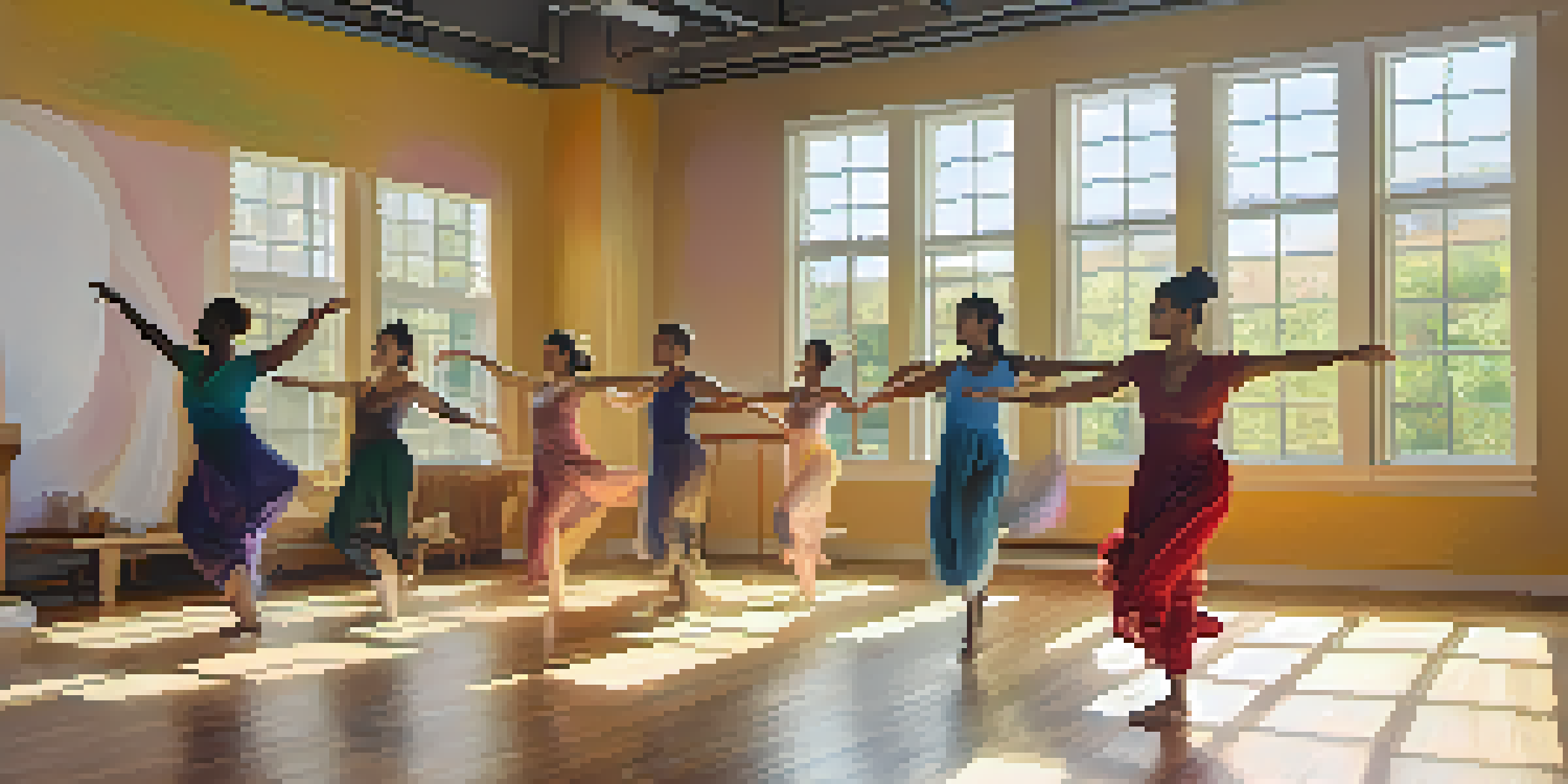Dance Therapy: Using Movement to Express and Heal Emotions

What is Dance Therapy and How Does it Work?
Dance therapy, or dance/movement therapy (DMT), combines psychology and movement to promote emotional and physical healing. It encourages individuals to express their feelings through movement, creating a unique form of communication that transcends words. This therapy is based on the understanding that our bodies hold emotions, and by moving, we can release pent-up feelings that may be difficult to articulate.
Dance is the hidden language of the soul.
The practice involves a trained therapist guiding individuals or groups in structured movement activities designed to foster self-awareness and emotional expression. For example, a therapist might ask participants to reflect on a specific emotion and then express that feeling through dance. This process not only helps in understanding one’s feelings but also supports personal growth and healing.
Research has shown that dance therapy can be effective for various mental health issues, such as anxiety, depression, and trauma. Participants often report feeling more connected to their bodies and emotions, leading to increased self-esteem and a better sense of well-being. In essence, dance therapy serves as a bridge between the mind and body, fostering holistic healing.
The Psychological Benefits of Dance Therapy
One of the most compelling aspects of dance therapy is its ability to address psychological issues through movement. When individuals engage in dance, they often experience a release of endorphins, which can improve mood and reduce feelings of stress and anxiety. This biochemical response is akin to a runner's high, where the body naturally uplifts spirits through physical activity.

Moreover, dance therapy creates a safe space for participants to explore their emotions without judgment. This non-verbal form of expression allows individuals to communicate their feelings and experiences in a way that may feel less vulnerable than traditional talk therapy. For many, the act of moving can unlock emotions that have been buried deep, providing a pathway for healing.
Dance Therapy Promotes Healing
Dance therapy combines movement and psychology to help individuals express emotions and facilitate emotional and physical healing.
Additionally, the social aspect of group dance therapy fosters connections among participants. Engaging in movement as a collective encourages empathy and understanding, helping individuals to feel less isolated in their struggles. This sense of community can be a powerful catalyst for healing, as shared experiences often lead to mutual support.
How Dance Therapy Can Help with Trauma Recovery
Trauma can have a profound impact on both mental and physical health, often manifesting as anxiety, depression, or even chronic pain. Dance therapy offers a unique approach to trauma recovery by allowing individuals to reconnect with their bodies in a safe and supportive environment. This can be particularly important for those who have experienced trauma, as it helps them regain a sense of agency over their physical selves.
The body says what words cannot.
Through movement, individuals can express emotions related to their trauma that may be too painful to discuss verbally. For instance, a survivor of abuse might use dance to articulate feelings of anger or fear, providing an outlet for healing. The process of moving can also encourage individuals to reclaim their bodies, fostering a sense of empowerment and confidence.
In many cases, dance therapy can work alongside other therapeutic modalities, creating a comprehensive approach to recovery. By integrating movement with traditional talk therapies, individuals can experience a more holistic healing journey. Ultimately, dance therapy can serve as a vital tool in the ongoing process of trauma recovery.
The Role of a Dance Therapist
A dance therapist is a trained professional who integrates dance and movement with therapeutic practices. They hold specific qualifications, often including a degree in dance/movement therapy, psychology, or a related field. Their expertise enables them to assess individual needs and tailor sessions to support emotional and psychological healing.
During sessions, the therapist creates a safe and welcoming environment where clients feel comfortable expressing themselves. They might guide participants through specific movement exercises, encourage improvisation, or facilitate group dances that promote connection and interaction. The therapist's role is to observe and interpret movements, helping clients gain insight into their emotions and behaviors.
Benefits for Trauma Recovery
Through movement, dance therapy allows trauma survivors to reconnect with their bodies and express feelings that may be too painful to articulate verbally.
Furthermore, dance therapists are trained to recognize and address any potential emotional triggers that may arise during sessions. They provide support and guidance to help clients navigate these feelings safely. This supportive presence is essential in ensuring that the therapeutic process is both beneficial and respectful of each individual's journey.
Incorporating Dance Therapy into Your Life
If you're interested in exploring dance therapy, there are various ways to incorporate it into your life. Many communities offer classes or workshops led by certified dance therapists, providing an opportunity to experience the benefits firsthand. These sessions often cater to different skill levels, making them accessible to everyone, regardless of prior dance experience.
You can also create your own dance therapy practice at home. Find a quiet space, put on some music that resonates with you, and allow yourself to move freely. This practice not only encourages emotional expression but also helps you tune into your body and its needs. Remember, the goal is not to perform but to feel; let the music guide your movements and embrace whatever emotions arise.
Additionally, consider pairing dance therapy with other self-care practices, such as journaling or meditation. Reflecting on your dance experiences in writing can deepen your understanding of your emotions and provide clarity. By combining these practices, you create a holistic approach to emotional well-being that nurtures both mind and body.
Real-Life Success Stories: Dance Therapy in Action
Numerous individuals have experienced transformative changes through dance therapy, illustrating its powerful impact. For example, a young woman who struggled with anxiety found solace in a weekly dance therapy group. Over time, she learned to express her feelings through movement, which not only reduced her anxiety symptoms but also boosted her confidence in social settings.
Another inspiring story involves a veteran coping with PTSD. Through dance therapy, he discovered a new way to process his traumatic experiences. The therapist encouraged him to channel his emotions into movement, allowing him to confront his pain in a safe and supportive environment. This journey not only helped him heal but also fostered a renewed sense of purpose and connection with others.
Expanding Access to Dance Therapy
The rise of online platforms is making dance therapy more accessible, allowing individuals to experience its benefits from the comfort of their homes.
These success stories underscore the versatility and effectiveness of dance therapy across various demographics and issues. Whether it’s for anxiety, trauma, or simply a desire for self-exploration, many individuals have found healing and empowerment through movement. This speaks to the universal nature of dance as a form of expression and connection.
The Future of Dance Therapy: Expanding Awareness and Access
As awareness of mental health continues to grow, so does the recognition of dance therapy as a legitimate therapeutic practice. More mental health professionals are beginning to incorporate movement-based therapies into their offerings, expanding access to these healing modalities. This shift reflects a broader understanding of the importance of holistic approaches to well-being.
Furthermore, technology is playing a role in making dance therapy more accessible. Online platforms are emerging, offering virtual dance therapy sessions that allow individuals to participate from the comfort of their homes. This innovation is particularly beneficial for those who may have mobility issues or live in remote areas where access to therapists is limited.

Looking ahead, continued research and advocacy will be essential in promoting the benefits of dance therapy. By sharing success stories and highlighting its effectiveness in various contexts, professionals can inspire more individuals to explore this unique path to emotional healing. The future of dance therapy holds promise, as it continues to evolve and reach those in need of support and healing.